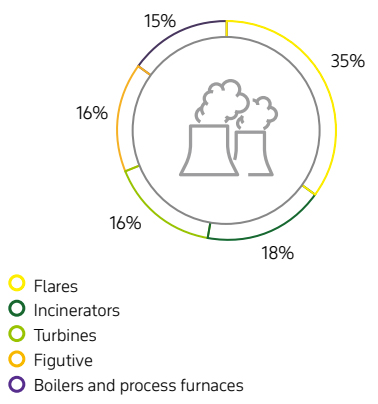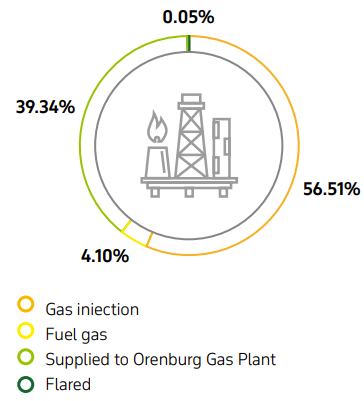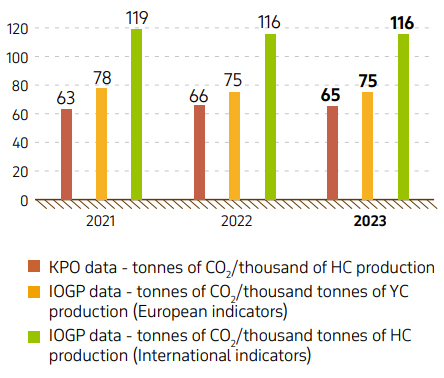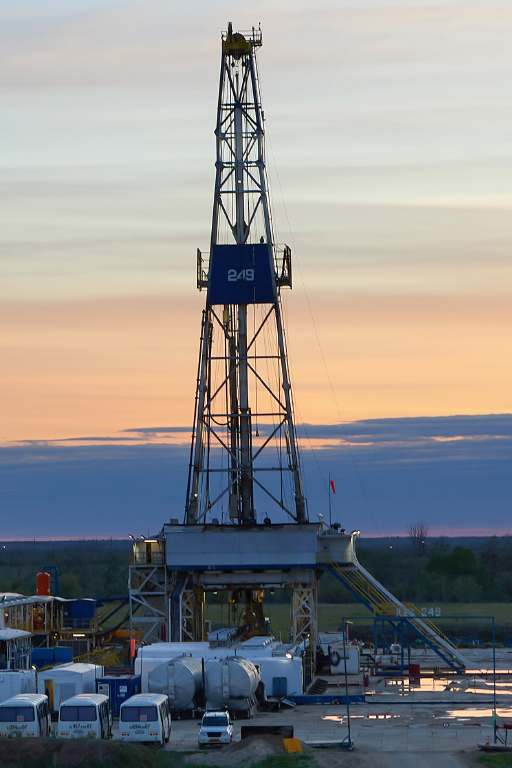Air emissions
KPO manages air pollutant emissions based on the limits established in the Environmental Impact Permit.
To control compliance with the limits, the Company monitors industrial emissions. At the KPO facilities, the air emissions are mainly released from sour gas and formation fluid contamination mixtures’ (FFCM) flaring, fuel gas flaring in turbines, furnaces and boilers, from diesel fuel flaring in diesel-generator units. The sulphur dioxide, carbon oxide and nitrogen oxides are the main combustion products.
Regulation of direct greenhouse gas (GHG) emissions in KPO is carried within the framework of the current National Emissions Quotas’ Trading System.
Tab. 33.Targets in managing emissions
|
Our 2023 targets |
Target achievement status |
Actions taken to complete targets in 2023 |
Targets for 2024 |
|
Conduct analysis and studies on additional efficient off-gas treatment plants for KPC incinerators |
Completed |
The Report “Analysis of emissions reduction opportunities for KPC incinerators” was issued. |
Conduct analysis for additional opportunities to implement Tail Gas Clean-up Units |
Graph 19.Pollutant emissions in KPO by main air pollution sources, in 2023


In 2023, the total amount of air emissions was increased by 10 % compared to 2022, totalling 5,765 tonnes. The increase in emissions in 2023 is justified by the increase of condensate production by 7 %, and gas by 15 % compared to 2022, and inclusion of the contractor companies’ emissions under the Company’s obligation in accordance with the requirements of the RoK Environmental Code. Table 34 shows data on the permissible and actual KPO’s emissions for the period of 2021–2023.
IN 2023 THE POLLUTANT EMISSIONS TO AIR MADE
5,765TONNES
Tab. 34.Permitted and actual volumes of pollutant emissions, 2021–2023
|
Annual volume of emissions by pollutants, in tonnes: |
2023 |
2022 |
2021 |
|
Permitted emissions: |
11,346 |
12,005 |
13,219 |
|
Actual, including: |
5,765 |
5,236 |
4,798 |
|
Nitrogen oxides (NOх) |
1,362 |
1,182 |
1,197 |
|
Sulphur dioxide (SO2) |
2,251 |
2,143 |
1,989 |
|
Carbon dioxide (CO2) |
1,159 |
1,142 |
1,039 |
|
Volatile organic compounds |
513 |
534 |
452 |
|
Hydrogen sulphide – H2S |
3 |
3 |
3 |
|
Solid particles |
441 |
198 |
71 |
|
Other |
36 |
34 |
47 |
Note.: Emission volumes data are provided in accordance with the data of statistical report "2-TP Air
In KPO, emissions are calculated using the methods specified in MPE project and recommended for use in the Republic of Kazakhstan.
Graph 20.Hydrocarbons’ production and environmental emissions in 2021–2023

In 2023, the specific emissions per unit of production amounted to 0.19 tonnes per 1,000 tonnes of hydrocarbons (HC) produced same as in 2022.
Gas Flaring
In 2023, the total amount of gas flared reached 0.05 % (0.07 % in 2022) of the total volume of gas produced or 0.32 tonnes per thousand tonnes of produced hydrocarbons. Such a low flaring emission rate resultant from flaring testifies of high operational performance against the global industrial average rate of 8.57 tonnes per one thousand tonnes and European average rate of 2.55 tonnes per one thousand tonnes, as follows from the IOGP 2022’s Report. This confirms the very high level of KPO for this indicator among the global and European oil and gas producers and makes Karachaganak the leading oil and gas condensate field in Kazakhstan in terms of gas utilization.
Decrease in gas flaring volumes by 14 % in 2023 comparing to 2022 is related to absence of well operations associated with the hydrocarbons’ flaring during full shutdown of main facilities for turnaround and as well as due to commissioning works.
Graph 21.Volumes of produced gas flared in 2021–2023 (mln m3)

Gas Utilization
In accordance with legislation requirements, KPO develops and approves with Regulatory Bodies the programmes of sour gas processing development.
In 2023, the KPO gas utilization rate reached 99.95 % (99.93 % in 2022). The performance target approved by the RoK Authority under the 2023 Associated Gas Processing Development Programme is 99.84 %.
Graph 22.Gas utilization and flaring in 2023

Greenhouse gases
Direct Greenhouse Gas emissions
Regulation of direct greenhouse gas (GHG) emissions in KPO is conducted within the framework of the current National Emissions’ Quotas Trading System. KPO has obtained quotas for the 2023 GHG emissions (CO2) in the amount of 2,299,321 tonnes on the basis of specific emissions indicators (benchmarks). In 2023, actual emissions have amounted to 1,991,739 tonnes of CO2, which made 87 % of the quota. In January 2024 the residual of the 2022’s quota worth 480,948 tonnes of СО2 was added up to the Company.
In order to control the level of GHG emissions in line with the issued quota, KPO conducts GHG emissions assessment for for carbon dioxide (СО2) and methane (СН4) every quarter. The emissions were assessed using the calculation method on the basis of the Company’s operations data (in terms of fuel consumption and laboratory data on fuel composition) using the current Methodology Guidelines #280 of 05.11.2010 approved by the Environmental Authority.
Rates used for analysis of the GHG emissions are calculated quarterly as per the laboratory data of the certified KPO Chemical Laboratory.
To convert the GHG emissions into carbon dioxide equivalent (СO2-eq.), the global warming potential values were used according to item 4 of Decision of Conference of the Parties 6/СР.27 of November 17, 2022.
At the year-end, independent certified organization shall verify monitoring results and produce an Inventory report for the reporting period.
According to the verified GHG Emissions Inventory Report for 2023, the total volume of GHG emissions amounted to 2,012,982 tonnes in СО2-equivalent, of which СО2 contribution equalled to 1,991,739 tonnes of СО2-equivalent (99 %), CH4 – 12,805 tonnes of С?О2-equivalent (0.6 %), N2O – 8,438 tonnes of СО2-equivalent (0.4 %).
Information on the dynamics of generated GHG emissions is provided in table 35. The slight increase in GHG emissions (by 9 %) in 2023 compared to 2022 is related to full operation of the 4th Injection Compressor and its High Pressure Flare throughout the year while in 2022 this equipment operated only seven months.
Tab. 35.Dynamics of GHG emissions generated from KPO production activities, 2021–2023
|
Total volume of greenhouse gas emissions (tonnes of CO2-equivalent) |
|||||
|
From fuel combustion at stationary sources |
From fuel combustion at flares and incinerators |
Fugitive emissions |
Total GHG emissions in 2023 |
Total GHG emissions in 2022 |
Total GHG emissions in 2021 |
|
1,867,178 |
135,988 |
9,816 |
2,012,982 |
1,851,066 |
1,745,768 |
The methodology for calculating GHG emissions from fugitive emission sources
To count the GHG emissions from fugitive emission sources, KPO uses its own methodology developed for efficient monitoring and approved by the Ministry of Environmental Protection and Natural Resources of the Republic of Kazakhstan in 2020. This methodology has allowed gaining more accurate data of methane (СН4) emissions from fugitive emission sources at KPO facilities and significantly minimize calculations’ equivocation. The methodology is applied during the annual GHG emission inventory process.
The Scope 2 emissions calculation has been conducted only for the purchased energy in the field facilities.
Specific greenhouse gas emissions
In 2023, the KPO’s specific indicator of СО2 emissions totalled 66 tonnes of СО2/thousand tonnes of HC liquids production. Graph 23 shows the dynamics of specific GHG emissions comparing to the specific emissions data provided by the IOGP. The actual specific GHG emissions in KPO are lower than the European indicators by 14 % and lower than the international indicators by 44 %.
Graph 23.Dynamics of specific GHG emissions per unit of produced hydrocarbons (HC)*, 2021–2023

The data was sourced by Annual report of the International Associations of Oil and Gas Producers (IOGP) – “Environmental Performance Indicators – 2022 data”. The 2022 data was used for comparison purpose in 2023, as the 2023 IOGP Report was not available at the time this Report was prepared. The 2021 data were changed in the 2022 IOGP Report.
Indirect greenhouse gas emissions
Indirect GHG emissions at KOGCF resulting from the consumption of imported electric power in 2023 account for an insignificant part (0.1 %), since the Company has a gas turbine power plant, the main purpose of which is to provide its own electricity to the entire production complex of the Field and nearby settlements.
These emissions are not subject to accounting and are not included in the reporting under the internal system of quotas for GHG emissions of the Republic of Kazakhstan. Information on them is provided only in reports to KPO Parent Companies. In 2023, the indirect GHG emissions at KPO amounted to 980 tonnes of СО2.

Air pollution harms human health, affects food security, hinders economic development, leads to loss of biodiversity, contributes to climate change and degrades the environment that people rely on for their livelihoods. The United Nations recognize air pollution as one of the major threats to human and planetary health.
The KPO industrial complex operation is inevitably associated with the air pollutant emissions. Pollutants are generated on all process stages: production, preparation, storage and transportation of gas and condensate. Reduction of emissions, recycling of waste and application of new technologies remain the most important issues on the Company’s agenda. The Company’s mission in this matter is to minimize the negative impact of its activities.
